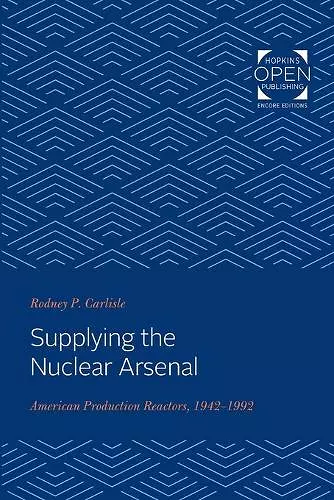Supplying the Nuclear Arsenal
American Production Reactors, 1942-1992
Rodney P Carlisle author Joan M Zenzen author
Format:Paperback
Publisher:Johns Hopkins University Press
Published:14th Apr '20
Currently unavailable, and unfortunately no date known when it will be back

Originally published in 1996. Although the history of commercial-power nuclear reactors is well known, the story of the government reactors that produce weapons-grade plutonium and tritium has been shrouded in secrecy. Supplying the Nuclear Arsenal looks at the origin and development of these production reactors, Rodney Carlisle and Joan Zenzen describe a fifty-year government effort no less complex, expensive, and technologically demanding than the Polaris or Apollo programs—yet one about which most Americans know virtually nothing.
Carlisle and Zenzen describe the evolution of the early reactors, the atomic weapons establishment that surrounded them, and the sometimes bitter struggles between business and political constituencies for their share of "nuclear pork." They show how, since the 1980s, aging production reactors have increased the risk of radioactive contamination of the atmosphere and water table. And they describe how the Department of Energy mounted a massive effort to find the right design for a new generation of reactors, only to abandon that effort with the end of the Cold War. Today, all American production reactors remain closed.
Due to short half-life, the nation's supply of tritium, crucial to modern weapons, is rapidly dwindling. As countries like Iraq and North Korea threaten to join the nuclear club, the authors contend, the United States needs to revitalize tritium production capacity in order to maintain a viable nuclear deterrent. Meanwhile, as slowly decaying artifacts of the Cold War, the closed production reactors at Hanford, Washington, and Savannah River, South Carolina, loom ominously over the landscape.
Carlisle and Zenzen trace the history, the pork-barrel tussles between businesses and political constituencies, and the massive technological and financial investment. They also point out that the now aging reactors are becoming ever more liable to failure and accident, and that though all the plants are closed now, the nuclear fuel is decaying toward its half-life and will need to be replenished if the U.S. is to remain the toughest kid on the block.
—SciTech Book News
ISBN: 9781421435909
Dimensions: unknown
Weight: 408g
298 pages